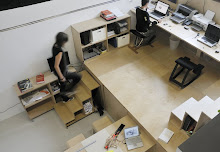
propuesta de Vertical Farm con diseño de ateliersoa. USOS MIXTOS CON VIVIENDAS, DOTACIONES E INVERNADORES EN ALTURA.
ALGUNOS EXTRACTOS:
By the year 2050, nearly 80% of the earth's population will reside in urban centers. Applying the most conservative estimates to current demographic trends, the human population will increase by about 3 billion people during the interim. An estimated 109 hectares of new land (about 20% more land than is represented by the country of Brazil) will be needed to grow enough food to feed them, if traditional farming practices continue as they are practiced today. At present, throughout the world, over 80% of the land that is suitable for raising crops is in use (sources: FAO and NASA). Historically, some 15% of that has been laid waste by poor management practices. What can be done to avoid this impending disaster?
A Potential Solution: Farm Vertically
The concept of indoor farming is not new, since hothouse production of tomatoes, a wide variety of herbs, and other produce has been in vogue for some time. What is new is the urgent need to scale up this technology to accommodate another 3 billion people. An entirely new approach to indoor farming must be invented, employing cutting edge technologies. The Vertical Farm must be efficient (cheap to construct and safe to operate). Vertical farms, many stories high, will be situated in the heart of the world's urban centers. If successfully implemented, they offer the promise of urban renewal, sustainable production of a safe and varied food supply (year-round crop production), and the eventual repair of ecosystems that have been sacrificed for horizontal farming.
It took humans 10,000 years to learn how to grow most of the crops we now take for granted. Along the way, we despoiled most of the land we worked, often turning verdant, natural ecozones into semi-arid deserts. Within that same time frame, we evolved into an urban species, in which 60% of the human population now lives vertically in cities. This means that, for the majority, we humans are protected against the elements, yet we subject our food-bearing plants to the rigors of the great outdoors and can do no more than hope for a good weather year. However, more often than not now, due to a rapidly changing climate regime, that is not what follows. Massive floods, protracted droughts, class 4-5 hurricanes, and severe monsoons take their toll each year, destroying millions of tons of valuable crops. Don't our harvestable plants deserve the same level of comfort and protection that we now enjoy? The time is at hand for us to learn how to safely grow our food inside environmentally controlled multistory buildings within urban centers. If we do not, then in just another 50 years, the next 3 billion people will surely go hungry, and the world will become a much more unpleasant place in which to live.
A Potential Solution: Farm Vertically
The concept of indoor farming is not new, since hothouse production of tomatoes, a wide variety of herbs, and other produce has been in vogue for some time. What is new is the urgent need to scale up this technology to accommodate another 3 billion people. An entirely new approach to indoor farming must be invented, employing cutting edge technologies. The Vertical Farm must be efficient (cheap to construct and safe to operate). Vertical farms, many stories high, will be situated in the heart of the world's urban centers. If successfully implemented, they offer the promise of urban renewal, sustainable production of a safe and varied food supply (year-round crop production), and the eventual repair of ecosystems that have been sacrificed for horizontal farming.
It took humans 10,000 years to learn how to grow most of the crops we now take for granted. Along the way, we despoiled most of the land we worked, often turning verdant, natural ecozones into semi-arid deserts. Within that same time frame, we evolved into an urban species, in which 60% of the human population now lives vertically in cities. This means that, for the majority, we humans are protected against the elements, yet we subject our food-bearing plants to the rigors of the great outdoors and can do no more than hope for a good weather year. However, more often than not now, due to a rapidly changing climate regime, that is not what follows. Massive floods, protracted droughts, class 4-5 hurricanes, and severe monsoons take their toll each year, destroying millions of tons of valuable crops. Don't our harvestable plants deserve the same level of comfort and protection that we now enjoy? The time is at hand for us to learn how to safely grow our food inside environmentally controlled multistory buildings within urban centers. If we do not, then in just another 50 years, the next 3 billion people will surely go hungry, and the world will become a much more unpleasant place in which to live.

















No hay comentarios:
Publicar un comentario